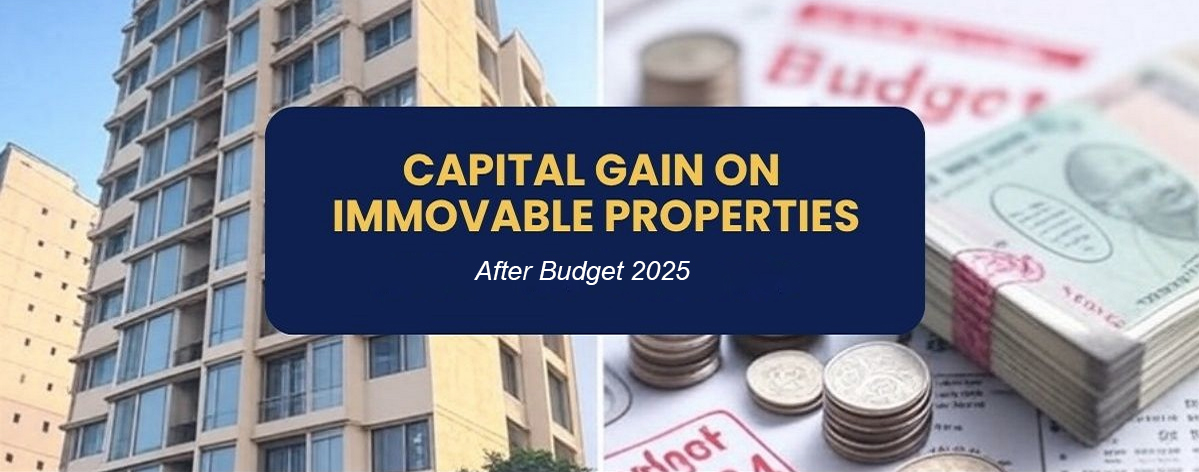Long Term Capital Gain on Immovable Properties – After Budget 2025
If you’re planning to sell property in India, understanding Long Term Capital Gains (LTCG) on immovable assets—like land, residential flats, or commercial buildings—is crucial. With the Union Budget 2025 introducing important changes, here’s your updated guide on LTCG on immovable properties.
🔍 What is Long Term Capital Gain (LTCG)?
LTCG arises when an immovable property (land or building) is sold after being held for more than 24 months. The profit from the sale, after adjusting for inflation, is taxed under special provisions of the Income Tax Act.
🆕 Budget 2025: What’s New for LTCG?
Budget 2025 focused on rationalizing exemptions and improving tax transparency. Here are the key changes:
- Digital Property Registry Integration
- A centralized digital registry is now linked to PAN and Aadhaar, allowing the Income Tax Department to track property transactions more efficiently.
- Revised Valuation Guidelines
- The government revised Fair Market Valuation (FMV) rules for circle rates and transaction values. If a property is sold 10% below the stamp duty value, capital gains will now be calculated based on stamp duty value.
- Cap on Section 54/54F Exemption Retained
- The ₹10 crore cap on LTCG exemptions under Section 54 and Section 54F, introduced in Budget 2023, remains unchanged.
📊 LTCG Tax Rates for Immovable Property (Post-Budget 2025)
Particulars | Tax Rate |
LTCG on sale of land/building | 20% with indexation |
Surcharge | 10%–25% (based on income slab) |
Health & Education Cess | 4% |
📆 Holding Period Criteria
- Short-Term Capital Gain (STCG): Held for ≤ 24 months
- Long-Term Capital Gain (LTCG): Held for > 24 months
Indexation benefits apply only to LTCG, not STCG.
🛡️ Exemptions Available on LTCG
You can reduce or eliminate your LTCG tax liability by using these sections:
🔹 Section 54:
- For individuals/HUFs selling residential property
- Reinvest in another residential property within 1 year before or 2 years after sale (or 3 years if under construction)
🔹 Section 54F:
- For sale of any capital asset (not necessarily residential)
- Reinvest entire sale consideration into one residential house
🔹 Section 54EC:
- Invest LTCG in NHAI/REC bonds
- Investment limit: ₹50 lakh
- Investment time frame: Within 6 months of sale
🧮 LTCG Calculation Example (FY 2025–26)
Purchase Year: FY 2014-15 | Cost: ₹60 lakh
Sale Year: FY 2025-26 | Sale Price: ₹1.8 crore
Indexed Cost (CII): ₹60 lakh × (CII 2025 ÷ CII 2014)
→ ₹60 lakh × (355 ÷ 240) = ₹88.75 lakh
LTCG = ₹1.8 crore – ₹88.75 lakh = ₹91.25 lakh
Tax = 20% of ₹91.25 lakh = ₹18.25 lakh + cess/surcharge
📋 Required Documents
To ensure smooth computation and exemption claim, maintain:
- Purchase and sale deeds
- Cost of improvement receipts
- Indexation records (CII table)
- Proof of reinvestment (new property/bonds)
- PAN, Aadhaar, Form 26AS
🚨 Non-Compliance Consequences
Failing to report LTCG or incorrectly claiming exemptions may lead to:
- Tax notices or scrutiny
- Interest and penalty under Section 234A/B/C
- Disallowance of exemption claims
✅ Expert Tips for FY 2025–26
- Plan your sale timing: Wait until after 24 months for LTCG benefits
- Use Capital Gains Account Scheme (CGAS) if reinvestment is pending
- Consult a tax expert to leverage exemptions and avoid pitfalls




